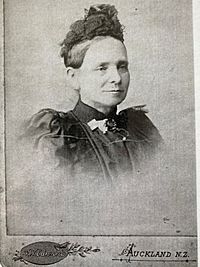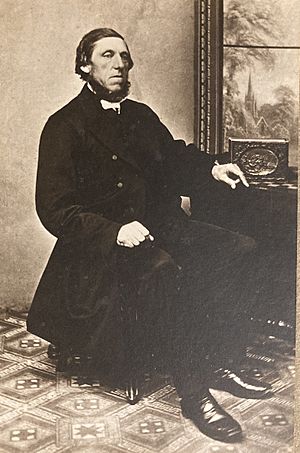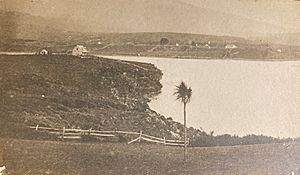Annie Schnackenberg facts for kids
Quick facts for kids
Annie Schnackenberg
|
|
|---|---|
 |
|
| Born |
Annie Jane Allen
22 November 1835 Leamington, Warwickshire, England
|
| Died | 2 May 1905 (aged 69) Morningside, Auckland, New Zealand
|
| Occupation | teacher, missionary |
| Known for | missionary, temperance and suffrage activist |
| Spouse(s) |
Cort Henry Schnackenberg
(m. 1864) |
| Parent(s) | Elizabeth Dodd and Edward Allen |
| Signature | |
Annie Jane Schnackenberg (born Allen; 22 November 1835 – 2 May 1905) was a very important woman in New Zealand's history. She was a Wesleyan missionary, a teacher, and a strong supporter of women's rights. She worked hard to help women and children, and she played a big part in getting women the right to vote in New Zealand.
Annie led the Auckland branch of the Women's Christian Temperance Union New Zealand (WCTU NZ) from 1887 to 1897. She was also the national president for WCTU NZ from 1892 to 1901. During this time, she helped push for women to get the right to vote in national elections. She was also a founding member of the National Council of Women of New Zealand.
Contents
Early Life
Annie Jane Allen was born in Leamington, England, on November 22, 1835. She was the oldest daughter of Elizabeth Dodd and Edward Allen. Her father owned a farm, and her parents also ran a fabric shop. Annie worked as a milliner, which means she made and sold hats. She had five younger brothers and sisters.
Moving to New Zealand and Missionary Work
In 1861, Annie and her family moved to New Zealand. They traveled on a ship called the Black Eagle. They became pioneer farmers in the Mount Albert area of Auckland.
Soon after arriving, Annie decided to teach at Wesleyan Mission schools. These schools were on the west coast of the Waikato region. She worked at a mission station run by Reverend Cort Henry Schnackenberg.
Annie traveled to Kawhia in November 1861. It was a difficult journey by bullock cart, canoe, and on foot, taking two weeks. At Kawhia, she helped Cort Schnackenberg and his wife Amy. They worked to educate and support the Māori people. People praised Annie's teaching work.
Amy Schnackenberg passed away in late 1863. Cort then asked Annie to marry him. They were married in Auckland on May 12, 1864. They had five children together:
- Katrina Elizabeth (born 1865)
- Amy Isabel Mary (born 1867)
- Edward Henry (born 1869)
- Thomas Carl (born 1871)
- Lucy Jane (born 1872)
The Waikato War in 1863–1864 made it hard for the mission to continue its work. Because of this, the church decided to move the mission further north to Raglan.
Annie and Cort stayed in Raglan until Cort's health became poor in 1880. He passed away on a ship while traveling to Auckland. Annie then returned to live at her family's farmhouse with her children.
Working for Change: Activism
After her husband's death, Annie became very active in her local church. By 1882, she was a leader at the Pitt Street Methodist Church. Here, she met other women who were working for social change.
Women's Christian Temperance Union
Annie was a founding member of the Auckland branch of the Women's Christian Temperance Union New Zealand (WCTU NZ) in 1885. The WCTU was a group that worked to reduce alcohol use and promote women's rights. Annie first led their education efforts.
In January 1887, she became the president of the Auckland branch, serving until 1897. She also became the national president of the WCTU in March 1892, a role she held until 1901. Because she knew the Māori people and spoke their language, she also led the WCTU's work with Māori communities from 1898. She also helped with their newspaper, The White Ribbon.
National Council of Women
The National Council of Women of New Zealand was formed in 1896. This group brought together many women's organizations. Annie represented the WCTU at their first meeting in Christchurch. She was chosen as a vice-president.
Fighting for the Right to Vote
When women in New Zealand won the right to vote in 1893, Annie Schnackenberg led a big celebration meeting in Auckland. A year later, she led another meeting to talk about the progress made since women gained the vote.
Annie strongly believed in protecting women. She wanted schools to teach about the dangers of alcohol. While this didn't become a required subject, the Department of Education did order books about it, making it possible to teach. She also campaigned for laws that would better protect young women. She believed young women needed more protection and advocated for laws that would keep them safe. She also spoke out against certain laws that treated women unfairly and against smoking and tattoos.
Other Groups She Helped
Annie Schnackenberg was a leader in many other important groups:
- Auckland Jubilee Kindergarten: She helped start and lead this kindergarten.
- Auckland Prohibition and Temperance League: Another group working to reduce alcohol use.
- Auckland Provincial Prohibition Council: A larger group with similar goals.
- Auckland Tailoresses' Union: A union for women who worked as tailors.
- Auckland Women's Franchise League: This group worked for women's right to vote.
- Mt. Albert Total Abstinence Society: A local group promoting avoiding alcohol.
- New Zealand Alliance for the Suppression and Prohibition of the Liquor Traffic: A national group working against alcohol.
- New Zealand Society for the Protection of Women and Children: A group that helped protect vulnerable women and children.
- Young Women's Christian Association (YWCA) Auckland: She was a vice-president and acting president for this group that supported young women.
Death
Annie's health began to decline, and she stepped down as president of the WCTU in 1901. She became more ill in 1903 and passed away on May 2, 1905. She was buried next to her husband in Symonds Street Cemetery.
See Also
- Women's Christian Temperance Union New Zealand
- Women's suffrage in New Zealand



